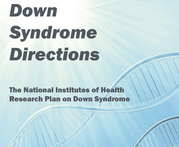I spent some time reading over the plan and offer this summarized version of the information – concentrating on what affects parents and caregivers of adults who have Ds.
How It’s Divided
- Research goals (short and long term)
- Bibliography of studies published since 2007
- Input provided by the Down syndrome community
- Meetings, websites, and congressional report language since 2007
Research goals are broken down into five major categories:
- Pathophysiology of Down Syndrome and Disease Progression
- Down Syndrome-Related Conditions: Screening, Diagnosis, and Functional Measures
- Treatment and Management
- Down Syndrome and Aging
- Research Infrastructure
Some Concerns
Research on improving cognition in people with Down syndrome should be the major focus of the Research Plan – Agreed in part; it is a major focus, but given the other health issues in the Down syndrome population, it is not the sole focus.
FISCAL YEAR 2014 (SENATE REPORT 113-071)
Down Syndrome – The Committee applauds NIH for the establishment of the Down Syndrome Patient Registry. The Committee urges continued investment and development of the registry to fully realize its potential as a tool to stimulate meaningful clinical trials and research. The Committee recognizes that investing in Down syndrome-focused research has the potential to benefit many other diseases and conditions such as Alzheimer’s disease. Therefore, the Committee urges NIH to seek public-private partnerships aimed at developing preventive therapies for the dementia associated with both Down syndrome and Alzheimer’s disease. The Committee remains troubled by the stagnant number of investigator-driven research awards given in the area of Down syndrome and supports efforts to increase the Federal investment. The Committee requests a status update in the fiscal year 2015 congressional budget justification. The Committee urges the NIH to continue to utilize the Down Syndrome Consortium as it updates and implements the NIH Down Syndrome Research Plan.
Determine whether individuals with cognitive impairment, including those with Down syndrome, could be considered as candidates for organ transplantation. (Status: Yet to begin.)
The Good News
- create and evaluate new technology,
- study the impact of aging on families and caregivers, and
- develop the research infrastructure needed to investigate racial disparities in health and survival rates.
Develop and/or adapt assistive devices, such as Global Positioning Systems (GPS) and mobile devices, to facilitate integration of an individual with Down syndrome into the workplace, residential or home environment, and community. (Status: In progress.)
As the lifespans of individuals with Down syndrome continue to increase, investigate the impact on families of caring for them as they age.
Develop a more complete demographic knowledge base, including factors that may contribute to differential survival rates among racial/ethnic groups, about individuals with Down syndrome. Use population-based data whenever feasible. (Status: In progress)
Continue to include cohorts of people with Down syndrome in appropriate longitudinal epidemiologic research and cross-sectional studies, including those investigating the trajectory and risk factors for psychopathology across the lifespan. Work toward the development of an adult cohort of people with Down syndrome in different areas of the United States. (Status: In progress.)
Consider ways to include participants with Down syndrome, including those of racial or ethnic minorities, in NIH-funded clinical trials.
What’s Been Done
- Better defined common effects of aging in people with Down syndrome
- Found that families (including parents and siblings) of individuals with Down syndrome have better quality of life than families with a member who has another developmental disability
- Formed the Down Syndrome Consortium
- Launched DS-Connect®: The Down Syndrome Registry
- Developed and validated a battery of cognitive tests to capture the range of effects of Down syndrome
What the Community Asked For
- Support innovative efforts to increase physical fitness for obesity prevention and cognitive improvement – Agreed; revised
- Develop a website to share research-related information about Down syndrome – Agreed; revised
- Increase collaboration with the Down syndrome community – Agreed; revised
- Expand the population statistics collected on Down syndrome – Agreed in part; this is the Centers for Disease Control and Prevention’s (CDC’s) purview
- Collect data on differential survival rates among sub-populations of people with Down syndrome – Agreed; revised
- Support longitudinal research on the risk factors and trajectory of psychopathology in people with Down syndrome – Agreed; revised
- Develop a cohort for studies on adults with Down syndrome – Agreed; revised
- Study the lifespans of parents of individuals with Down syndrome, considering the development of Alzheimer’s disease in the mothers – Agreed; see D.5
- Investigate the role of caretakers of people with Down syndrome – Agreed; see D.5
20 research articles published since 2007 that may interest caregivers of adults:
Disabil, Jan;116(1): 3-15. Erratum in Am J Intellect Dev Disabil, 2011, May;116(3): ii
Esbensen AJ, Mailick MR, Silverman W. (2013.) Long-term impact of parental well-being on adult outcomes and dementia status in individuals with Down syndrome. Am J Intellect Dev Disabil, Jul;118(4): 294-309.
Esbensen AJ, Seltzer MM, Greenberg JS. (2007.) Factors predicting mortality in midlife adults with and without Down syndrome living with family. J Intellect Disabil Res, Dec;51(Pt 12): 1039-50
Esbensen AJ, Seltzer MM, Krause MW. (2008.) Stability and change in health, functional abilities, and behavior problems among adults with and without Down syndrome. Am J Ment Retard, Jul;113(4): 263 77
Esbensen AJ, Seltzer MM. (2011.) Accounting for the Down syndrome advantage? Am J Intellect Dev
Esbensen AJ. (2010.) Health conditions associated with aging and the end of life of adults with Down syndrome. Int Rev Res Ment Retard, 39(C): 107-126
Fisher MH, Moskowitz AL, Hodapp RM. (2013.) Differences in social vulnerability among individuals with autism spectrum disorder, Williams syndrome, and Down syndrome. Res Autism Spectr Disord, Aug1;7(8): 931-937
Head E, Silverman W, Patterson D, Lott IT. (2012.) Aging and Down syndrome. Curr Gerontrol Geriatr Res, 2012: 412536
Krinsky-McHale SJ, Devenny DA, Gu H, Jenkins EC, Kittler P, Muety VV, Schupf N, Scotto L, Rycko B, Urv TK, Ye L, Zigman WB, Silverman W. (2008.) Successful aging in a 70-year old man with Down syndrome: A case study. Intellect Dev Disabil, Jun;46(3): 215-28.
Krinsky-McHale SJ, Devenny DA, Kittler P, Silverman W. (2008.) Selective attention deficits associated with mild cognitive impairment and early stage Alzheimer’s disease in adults with Down syndrome. Am J Ment Retard, 113(5): 369-86.
Krinsky-McHale SJ, Jenkins EC, Zigman WB, Silverman W. (2012.) Ophthalmic disorders in adults with Down syndrome. Curr Gerontol Geriatr Res, 2012: 974253.
Lott IT, Doran E, Nguyen VQ, Tournay A, Head E, Gillen DL. (2011.) Down syndrome and dementia: A randomized, controlled trial of antioxidant supplementation. Am J Med Genet A, Aug;155A(8): 1939-48.
Lott IT, Doran E, Nguyen VQ, Tournay A, Movsesyan N, Gillen DL. (2012.) Down syndrome and dementia: Seizures and cognitive decline. J Alzheimers Dis, 29(1): 177-85
Maenner Mj, Smith LE, Hong J, Mukuch R, Greenberg JS, Mailick MR. (2013.) Evaluation of an activities-of-daily-living scale for adolescents and adults with developmental disabilities. Disabil Health J, Jan;6(1): 6-17.
McKelvey KD, Fowler TW, Akel NS, Kelsay JA, Gaddy D, Wenger GR, Suva LJ. (2013.) Low bone turnover and low bone density in a cohort of adults with Down syndrome. Osteoporos Int, Apr;24(4): 1333-8.
Skotko BG, Levine SP, Goldstein R. (2011.) Self-perceptions for people with Down syndrome. Am J Med Genet A, Oct;155A(10): 2360-9.
Urv TK, Zigman WB, Silverman W. (2008.) Maladaptive behaviors related to dementia status in adults with Down syndrome. Am J Ment Retard, Mar;113(2): 73 – 86
Urv TK, Zigman WB, Silverman W. (2010.) Psychiatric symptoms in adults with Down syndrome and Alzheimer’s disease. Am J Intellect Dev Disabil, Jul;115(4): 265-76.
Wallace RA, Dalton AJ. (2011.) What can we learn from the study of Alzheimer’s disease in patients with Down syndrome for early-onset Alzheimer’s disease in the general population? Alzheimers Res Ther, Apr19;3(2): 13
Zigman WB, Schupf N, Jenkins EC, Urv TK, Tycko B, Silverman W. (2007.) Cholesterol level, statin use, and Alzheimer’s disease in adults with Down syndrome. Neurosci Lett, Apr18;416(3): 279-84.
Zigman WB, Silverman W. (2013.) Atypical aging in Down syndrome. Dev Disabil Res Rev, Aug;18(1): 51-67.

